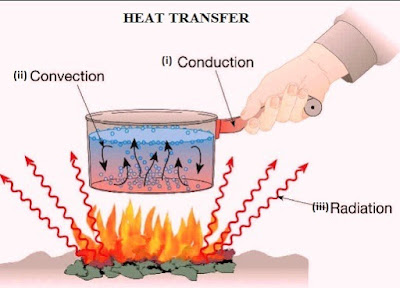Thermal Radiations The radiations emitted by a body due to
its temperature are called thermal radiations. All bodies not only emit the
thermal radiations, but also absorb these radiations from surroundings. If the
rate of emission of radiation is equal to the rate of absorption for a body,
then the body is said to be in thermal equilibrium. The radiations emitted by a
hot body depend not only on the temperature but also on the material of which
the body is made, the shape and the nature of the surface.
Cavity Radiator or
the Black Body
A perfect black body does not exist
Radiant Intensity
Energy emitted per unit area per unit time over all the wavelengths, is called radiant intensity. It is denoted by (RI)
Or
Power radiated per unit area over all the wavelengths is called radiant intensity.
Photo Electric Effect
The interaction between radiation and atoms of the cavity
lead to the idea of quantization of energy. It means that energy can be emitted
and radiated in the form of packets. Photo electric effect is another example
of interaction between radiation and matter.
Definition
When a light of suitable frequency falls on a metal surface,
the electrons are emitted out. These electrons are called photo electrons and
this phenomenon is called photo electric effect.
Experimental Set-up
The apparatus used to study the photo electric effect is
shown in the figure. The light of a suitable frequency falls on the metal
surface, which is connected to the negative terminal of variable voltage
source. If the frequency is high enough, the electrons are emitted out from
metal plate and accelerate towards anode. These electrons are called photo
electrons and current flows through circuit due to photo electrons is called photo
electric current. This phenomenon is called photo electric effect.
Maximum K.E of Photo
Electrons
The maximum K.E of photo electrons can be measured by
reversing the polarity of the battery. Now the photo electric current will be
reduced. The photo electric current does not drop to zero immediately because
the photo electrons emit from metal plate with different speeds. Some will
reach the cathode even though the potential difference opposes their motion.
However if we make the reversed
potential difference large enough c2
(called stopping potential) at which the
photo electric current drops to zero. This
potential difference multiplied by the
electronic charge C gives the maximum
kinetic energy of photo electrons.
Mathematically, the maximum kinetic
energy H(34 of photo electrons is
described as:
potential difference large enough c2
(called stopping potential) at which the
photo electric current drops to zero. This
potential difference multiplied by the
electronic charge C gives the maximum
kinetic energy of photo electrons.
Mathematically, the maximum kinetic
energy H(34 of photo electrons is
described as:
H(34 Cc2
where c2 is the stopping potential and C is the charge of an electron.
where c2 is the stopping potential and C is the charge of an electron.
Photo Electric Effect
on the Basis of Classical Wave Theory
According to classical wave theory, the
light consists of electromagnetic waves and their function is to transfer
energy from one place to another. When light falls on metal surface, it transfer energy to the electrons continuously. When an electron acquires sufficient energy, it escapes out the metal surface.
This theory successfully explains the emission electrons apparently, but this theory can’t explain the three major features of photo electric effect.
· The Intensity Problem
· The Frequency Problem
· Time Delay Problem
The
Intensity Problem According to classical wave theory, the light consists of scillating electric and magnetic vector, which increases in amplitude as the intensity of light beam is increased. Since the force applied to the electrons is ‘CH2’, therefore the kinetic energy of the electrons should also increased with the intensity of light. However, the experimental results suggest that the K.E of electrons is independent of intensity of light.
The Frequency Problem
According to classical wave theory, the photo electric effect should occur for any frequency of light provided that ncident light is intense enough to supply the energy needed to eject the photo electrons
Time Delay Problem
The classical wave theory predicts that there must be a time interval between the incidence of light on the metal surface and the emission of photo electrons. During this time, the electron should be absorbing energy from the beam until it has accumulated enough energy to escape the metal surface. However the experimental results show that there is no detectable time interval between the incidence of light and emission of photo electrons provided that frequency of light is equal to or greater than the threshold frequency.
Photons
In 1905, Einstein proposed quantum theory to explain the
photo electric effect, according to which the light consist of bundles or
packets of energy, called photons. The energy E of a single photon is
H
J d
where d is the frequency of light and J is the planks constant J 6.626 " 10%= J L s.
where d is the frequency of light and J is the planks constant J 6.626 " 10%= J L s.
According to quantum theory, on photon of energy is absorbed
by a single electron. If this energy is greater than or equal to a specific
amount of energy (called work function), then the electrons will be ejected,
otherwise not.

No comments:
Post a Comment